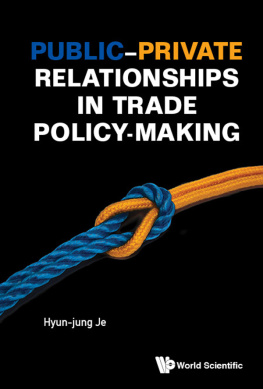WOMEN
and the
PUBLIC INTEREST
First published 1971 by Transaction Publishers
Published 2017 by Routledge
2 Park Square, Milton Park, Abingdon, Oxon OX14 4RN
711 Third Avenue, New York, NY 10017, USA
Routledge is an imprint of the Taylor & Francis Group, an informa business
Copyright 1971 by Jessie Bernard.
All rights reserved. No part of this book may be reprinted or reproduced or utilised in any form or by any electronic, mechanical, or other means, now known or hereafter invented, including photocopying and recording, or in any information storage or retrieval system, without permission in writing from the publishers.
Notice:
Product or corporate names may be trademarks or registered trademarks, and are used only for identification and explanation without intent to infringe.
Library of Congress Catalog Number: 2008015393
Library of Congress Cataloging-in-Publication Data
Bernard, Jessie, 19031996.
Women and the public interest : policy and protest in American life / Jessie Bernard.
p. cm.
Includes bibliographical references and index.
ISBN 978-0-202-36211-3
1. Feminism-United States. 2. Women-United States. I. Title.
HQ1426.B45 2008
305.420973--dc22 2008015393
ISBN 13: 978-0-202-36211-3 (pbk)
The only real justification of any social science is the degree to which it can creatively influence social policy and be one of the sources of constructive social action.
R OBERT A. N ISBET , The Social Bond
Contents
Women
and the
Public Interest
Public policy with respect to women as wives and mothers, as consumers, as sex objects, or as workers, whether embedded in ukase or legislation, or implicit in the mores, has an ancient if not always an honorable history. King Ahasueras, long before Paul, promulgated a law to the effect that wives should subordinate themselves to their husbands. As mothers, women have occupied policy makers concerned with population control. As consumers, wealthy Roman ladies were forbidden to wear more than a certain amount of gold; sumptuary laws in the middle ages specified the nature of womens garments. Then there is the whole inconsistent array of legislation with respect to women as sex objects dealing with prostitution and the sexual obligations of wives. With the advent of industrialization there was added to the common law a large corpus of legislation presumably in the public interest dealing with women as workers. Whether truly in the public interest or in the interest of the male part of the public, policy has thus been concerned with women from time immemorial.
Old as policy problems dealing with women are, they take on new salience in this age. Women are different; the public interest is different; norms are becoming different too. A new policy with respect to marriage is in process of crystallization in the form, for example, of the nonpunitive, no-fault divorce. A permissive policy with respect to family planning, except in regard to abortion, is no longer controversial. A nondiscriminatory policy with respect to womens work is formulated in Title VII of the Civil Rights Act of 1964. The implications for the public interest of these policies with respect to marriage, motherhood, and work, as well as the implications for women themselves, are only now being traced and evaluated.
Such evaluation is not easy. Policies dealing with women have always been complicated by the fact that there is sometimes a conflict between their interests and those of men, which has usually been resolvable in favor of men. But today they are also complicated, especially since the decline of the domestic system of organizing production, by a conflict between and among womens functions; especially their maternal functions and their industrial functions as defined in their family roles and their work roles. These conflicts are not easy to negotiate. In addition, policies are complicated also by the fact that there are conflicts among women themselves. Individuation is permitted to more women today, options are available to more of them. Women who show up on tests as having the interests of housewives see policies that foster careers for women as a threat to themselves directly or indirectly through their husbands; and the women Alice Rossi has denominated pioneers view policies tailored for the interests of housewives as obstacles to their own interests. Only very recently has the isolation of women from one another been breached enough to make solidarity among them feasible.
This essay is an attempt to bring into focus, from a wide variety of research sources in quite different research traditions, some of the issues that policy makers are going to have to wrestle with in relation to the functions of women in modern society. Not merely such issues as jobs, rights, and discrimination but also even more important ones such as functions, issues that would have arisen even if there had been no protesting women to dramatize them.
The most revolutionary of all the changes involving the public interest which now demand a re-examination of policy dealing with women are those concerned with the declining salience of the reproductive function of women and the technology that makes possible for an increasing proportion of women a divorce of reproduction from sexual relations. These changes call for a thorough reformulation of all our ideas about the sexual differentiation of functions.
This book is not an attempt to cover the whole waterfront, but just one small, though very significant, inlet. It addresses itself to some of the current paradoxes of policy as related to women and the processes now involved in dealing with them. It is an elaboration and up-dating of a position paper originally written for an agency of the executive branch of the government, and it is a sister-volume to a book on the future of marriage.
Although psychological variables are intrinsic to any study of women, the approach here is primarily sociological. After an introductory review in , a revolution in the not-too-distant future, if not signaling one already upon us today, for it is a great deal later than we thought it was yesterday.
I
Coming to Terms
No thoroughgoing coverage of all the possible meanings of the several terms in the title of this book is intended in Part One, but only enough to orient the discussion. A great deal of the confusion that arises in discussions about women arises because women are not all alike and few generalizations can be made that include all of them. It is to this diversity and the problems it poses for policy makers that addresses itself.
The public interest, or the general welfare, is not always self evident, nor is there even unanimity on its validity as a concept. Thus at least a nod of recognition is due to the complexity of the idea itself. No more than this is claimed. If, as the quotation from Robert Nisbet, the epigraph of this book, says, the only justification for the social sciences is to influence social policy, some recognition has also to be given to the nature of policy and, in the case of our own country at least, to the paradoxes () it has to contend with. The constructive social action in the present context includes the protests of modern women.










